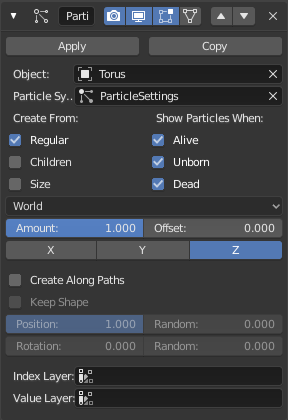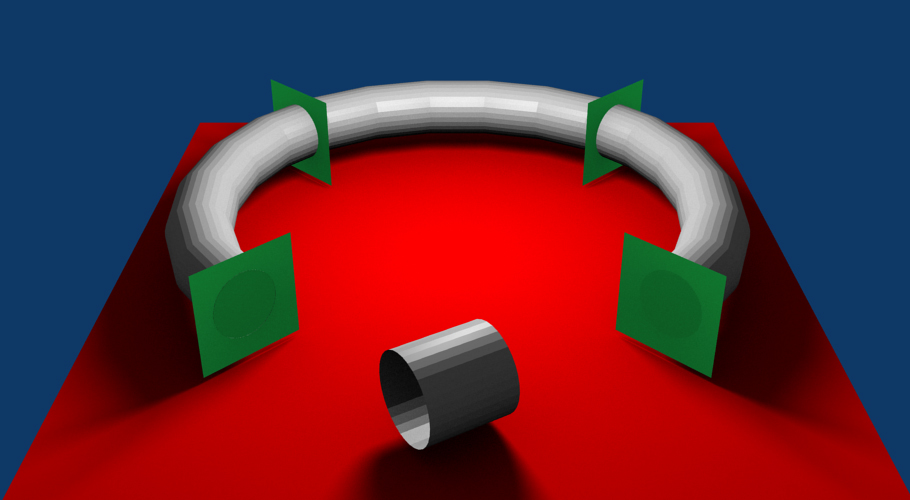Le modificateur Particle Instance¶
When a Particle Instance modifier is added to an object, the mesh of this object will be duplicated at the location of the particles of the selected Particle System from another target object. This means that to use this modifier, you must have at least one other object that has a Particles System on it.
Because of the correlation in which the Particle Instance modifier is influenced by the underlying particle systems on other objects, some of the apparent effects generated by the modifier can look and act vastly different, depending on the underlying settings of the particle systems it is associated with. This is worth taking account of, when it seems that the Particle Instance modifier settings do not return the expected results.
Options¶

Le modificateur Particle Instance.¶
- Object
L’objet cible qui a un système de particules qui lui est associé.
- Particle System
Le système de particules de l”Objet cible auquel ce modificateur est appliqué.
Create From¶
- Normal
Quand l’option est sélectionnée, le modificateur va utiliser les particules normales (parentes) pour copier le maillage de l’objet modifié.
- Children
Quand l’option est sélectionnée, le modificateur va utiliser les particules children pour copier le maillage de l’objet modifié.
- Size
Mettre à l’échelle les copies instancié du maillage par l’attribut de taille de particule. Quand ceci est désactivé, toutes les copies semblent être de la même taille que l’original.
Voir les panneaux Render et Children du système de particules pour les options de taille de particule.
Show Particles When¶
- Unborn
Quand l’option est sélectionnée, le modificateur va utiliser les particules unborn pour copier le maillage de l’objet modifié.
- Alive
Quand l’option est sélectionnée, le modificateur va utiliser les particules alive pour copier le maillage de l’objet modifié.
- Dead
Quand l’option est sélectionnée, le modificateur va utiliser les particules dead pour copier le maillage de l’objet modifié.
Options supplémentairees¶
- Space
- World, Local
Use World Space, or Local Space of the target object (that the particle system is assigned to).
World space means that the locations of the copies of the modified mesh will depend on the location of the modified object and of the target object.
Le pourcentage de particules à utiliser. Vous permet de sauter aléatoirement des particules pour ajuster la quantité de particules.
- Amount
The proportion of particles to be used. Allows you to randomly skip particles to adjust the amount of instances.
Avertissement
The random algorithm used currently only ensures that relative amount to be respected statistically. The actual amount of instances generated will differ from the theoretical one, depending on the Seed value of the target particle system (and the Offset value described below, too).
That deviation is not significant with high number of particles, but it will be highly noticeable with low numbers (e.g. with 100 particles in the target system, and an Amount value of
0.1, it can generate either up to 15 or 5 instances, instead of the 10 expected).- Offset
A relative offset in the range of particles used for instantiation. Allows you to avoid overlapping of the used particles, when the same particle system is used in multiple modifier instances.
Astuce
If you want to fully avoid overlaps, your Offset value must be at least as high as your Amount value.
- Rotation Axis X/Y/Z
Specify which axis of the modified object to use as pole axis to apply the rotation from the instantiated particles.
Utilisation de chemins¶
By default, the instances are placed depending on the particles position in the current frame. By enabling this option, you can select the position along the particles path regardless of the current frame.
You can adjust the particles” path (using the Path visualization type) on the Render panel of the Particle System tab.
Note
The particle system must be baked, except for Hair type or Keyed physics.
- Create Along Paths
This option tries to make the instance of the modified object to follow, to deform its shape along the particle path (or the hair strand).
- Keep Shape
Enabling this prevents the instance from being deformed, and places it on the path according to the Position value.
- Position
Spécifier le pourcentage du chemin que l’instance comble, ou la position sur le chemin si l’option Keep Shape est sélectionnée.
- Random
Ajoute un caractère aléatoire à la valeur Position de chaque instance.
- Rotation
Spécifie la rotation autour du chemin.
- Random
Ajoute un caractère aléatoire à la valeur Rotation de chaque instance.
Calques¶
These fields allow you to select vertex color layers, which will be filled with colors based on the particles information. These vertex color layers can be used, for example, in a shader to add variance to a material.
- Index Layer
Un calque de couleurs de sommet pour les valeurs basées sur l’indice des particules.
- Value Layer
Un calque de couleurs de sommet pour des valeurs par particule aléatoires.
Exemples¶

Exemple de Modificateur Particle Instance.¶
The render above shows a single plane mesh object assigned to two different vertex groups and each of those vertex groups is assigned to a separate and independent particle system, with each particle system being assigned to a different Particle Instance modifier. In the case shown the Particle Instance modifiers are added to a sphere and a cube. See example blend-file.

Exemple de Create Along Path.¶
Dans cet exemple, une particule Keyed isolée se déplace à travers quatre points (plans verts), suivant un chemin elliptique. Le modificateur Particle Instance est ajouté à un objet cylindre et ensuite associé au système de cette particule Keyed.
Quand le bouton Create Along Paths est activé, à la place de la position du cylindre suivant la position de la particule, le maillage du cylindre est adapté à la forme du chemin suivi par la particule. La géométrie de maillage de l’objet qui est déformé peut avoir un impact sur la manière dont la déformation est effectuée. Dans le cas du cylindre, il a de nombreuses coupes de loops sur toute sa longueur afin qu’il puisse se courber en ces points pour se déformer le long du chemin des particules.
The Particle Instance modifier Create Along Paths feature works for hair (strand) particles as well as with keyed particles. In this case, the mesh of the Particle Instance modifier will follow the length and profile of the hair strands paths.
Note
Strands, when they are generated, instantly die when created, so for the Create Along Paths checkbox to be of any use, you must also have the Dead checkbox enabled.